MBA Design Partnership: Leading and Managing Organizational Resources
VerifiedAdded on 2023/06/03
|16
|3654
|428
Report
AI Summary
This report provides a comprehensive analysis of leading and managing organizational resources, with a focus on ambidexterity within the context of MBA Design Partnership. It evaluates theoretical perspectives on ambidexterity, drawing from practitioner-oriented materials and academic literature, and examines its application across finance, information systems, operations, and leadership. The analysis incorporates intellectual capital resources, including organizational, social, and human capital, highlighting the importance of knowledge sharing and human resource practices in fostering ambidextrous capabilities. Furthermore, the report explores group and individual-level dynamics, transformational leadership, and knowledge management strategies. It also emphasizes the role of human resource management in developing a resource-based model for sustained competitive advantage, concluding with recommendations on how ambidexterity can add value to the organization. Desklib provides access to this and many other solved assignments.
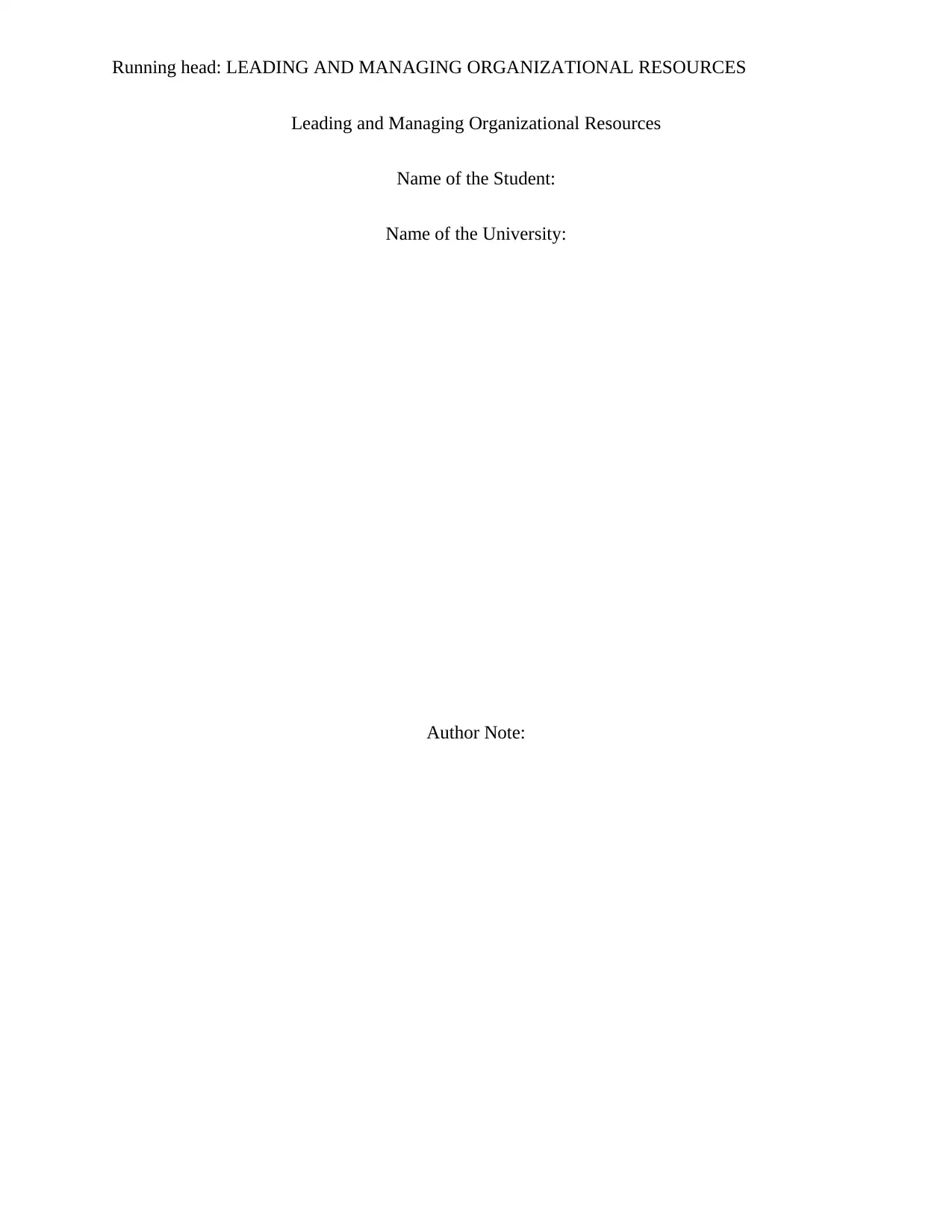
Running head: LEADING AND MANAGING ORGANIZATIONAL RESOURCES
Leading and Managing Organizational Resources
Name of the Student:
Name of the University:
Author Note:
Leading and Managing Organizational Resources
Name of the Student:
Name of the University:
Author Note:
Paraphrase This Document
Need a fresh take? Get an instant paraphrase of this document with our AI Paraphraser
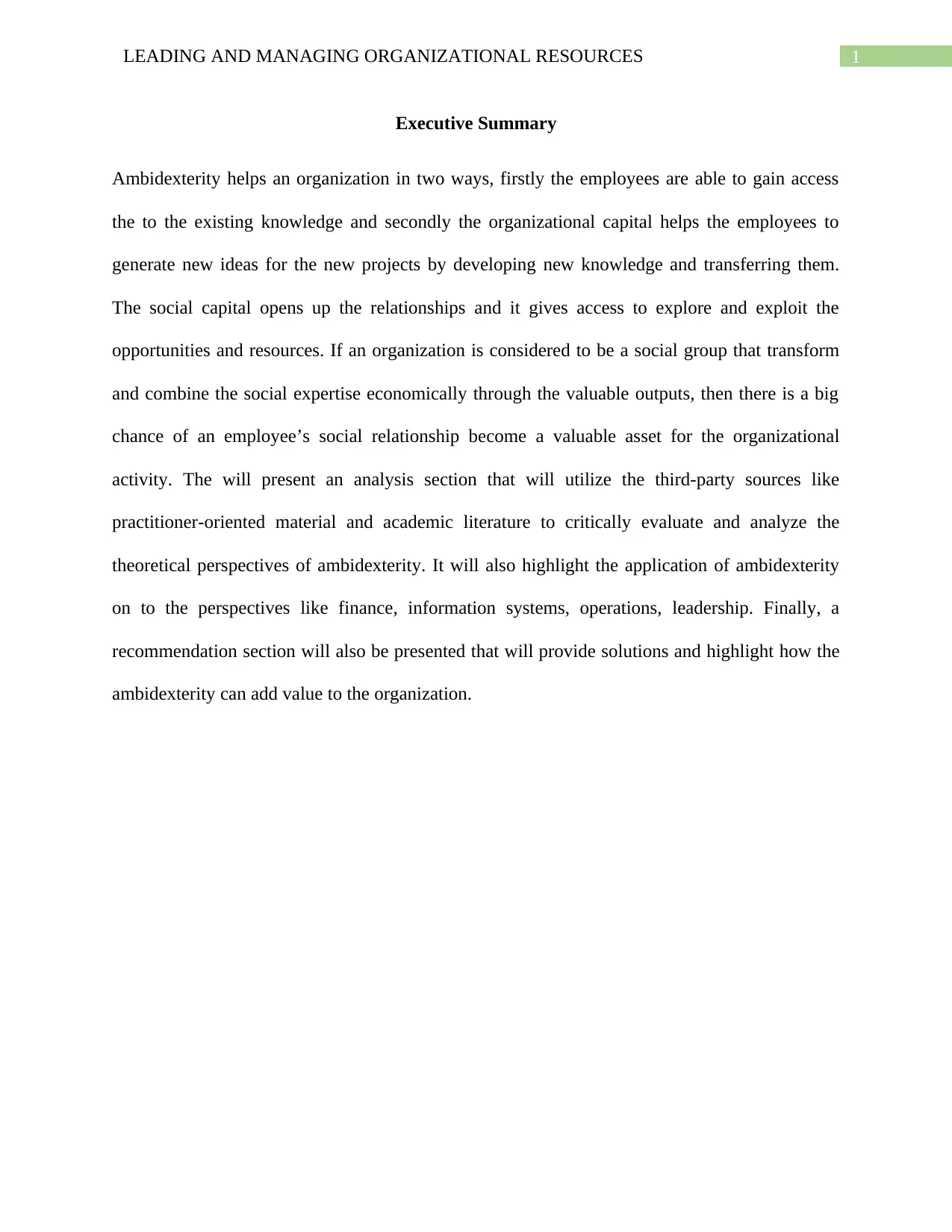
1LEADING AND MANAGING ORGANIZATIONAL RESOURCES
Executive Summary
Ambidexterity helps an organization in two ways, firstly the employees are able to gain access
the to the existing knowledge and secondly the organizational capital helps the employees to
generate new ideas for the new projects by developing new knowledge and transferring them.
The social capital opens up the relationships and it gives access to explore and exploit the
opportunities and resources. If an organization is considered to be a social group that transform
and combine the social expertise economically through the valuable outputs, then there is a big
chance of an employee’s social relationship become a valuable asset for the organizational
activity. The will present an analysis section that will utilize the third-party sources like
practitioner-oriented material and academic literature to critically evaluate and analyze the
theoretical perspectives of ambidexterity. It will also highlight the application of ambidexterity
on to the perspectives like finance, information systems, operations, leadership. Finally, a
recommendation section will also be presented that will provide solutions and highlight how the
ambidexterity can add value to the organization.
Executive Summary
Ambidexterity helps an organization in two ways, firstly the employees are able to gain access
the to the existing knowledge and secondly the organizational capital helps the employees to
generate new ideas for the new projects by developing new knowledge and transferring them.
The social capital opens up the relationships and it gives access to explore and exploit the
opportunities and resources. If an organization is considered to be a social group that transform
and combine the social expertise economically through the valuable outputs, then there is a big
chance of an employee’s social relationship become a valuable asset for the organizational
activity. The will present an analysis section that will utilize the third-party sources like
practitioner-oriented material and academic literature to critically evaluate and analyze the
theoretical perspectives of ambidexterity. It will also highlight the application of ambidexterity
on to the perspectives like finance, information systems, operations, leadership. Finally, a
recommendation section will also be presented that will provide solutions and highlight how the
ambidexterity can add value to the organization.
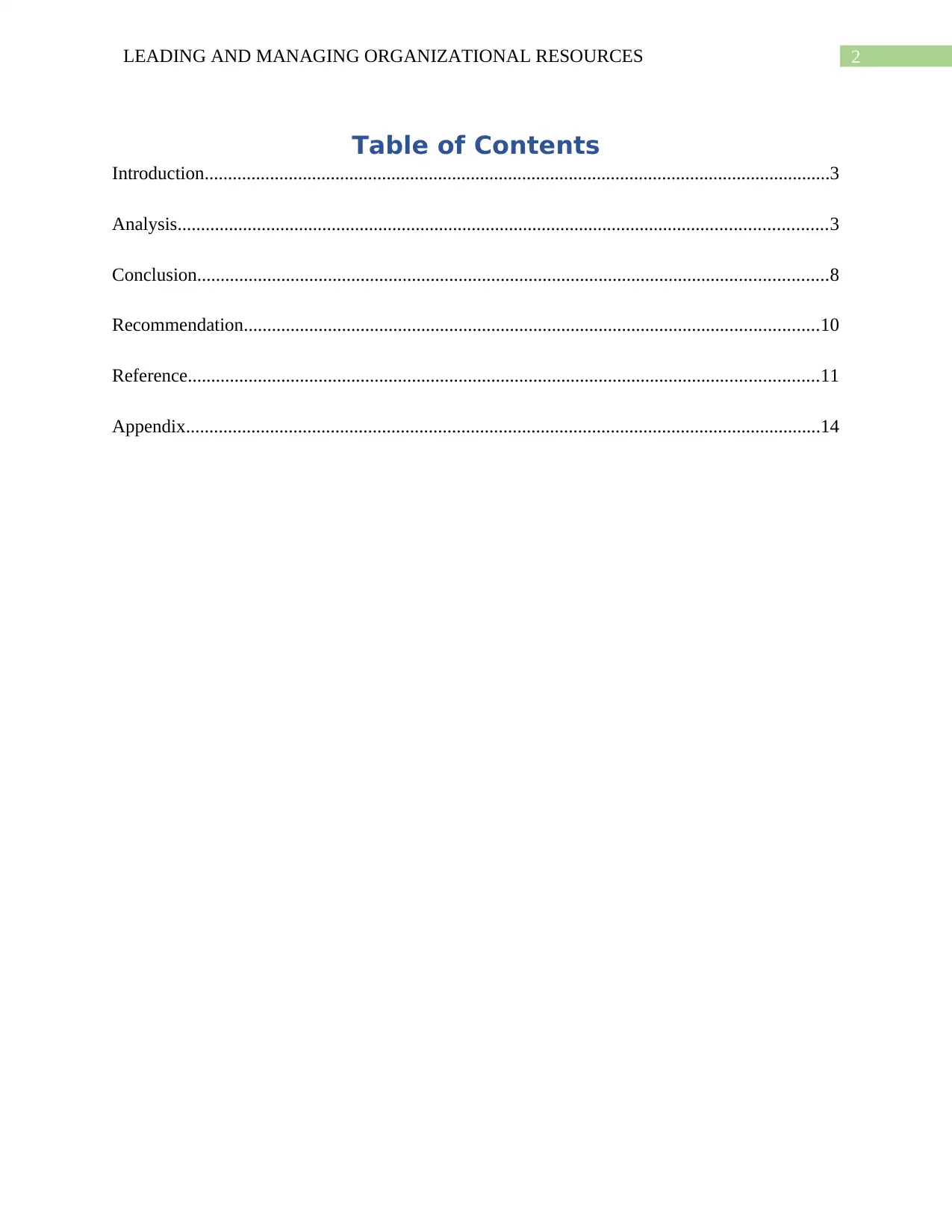
2LEADING AND MANAGING ORGANIZATIONAL RESOURCES
Table of Contents
Introduction......................................................................................................................................3
Analysis...........................................................................................................................................3
Conclusion.......................................................................................................................................8
Recommendation...........................................................................................................................10
Reference.......................................................................................................................................11
Appendix........................................................................................................................................14
Table of Contents
Introduction......................................................................................................................................3
Analysis...........................................................................................................................................3
Conclusion.......................................................................................................................................8
Recommendation...........................................................................................................................10
Reference.......................................................................................................................................11
Appendix........................................................................................................................................14
⊘ This is a preview!⊘
Do you want full access?
Subscribe today to unlock all pages.

Trusted by 1+ million students worldwide
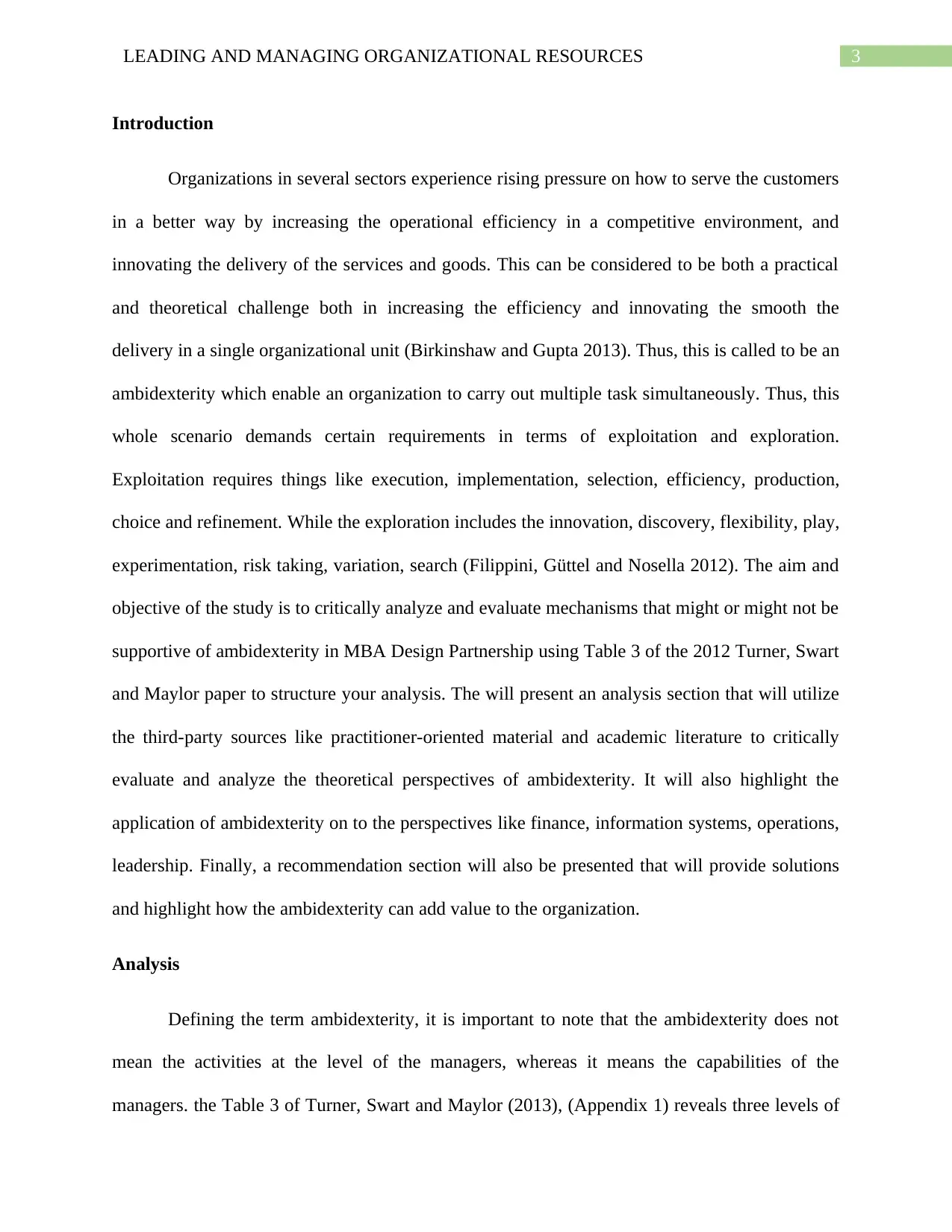
3LEADING AND MANAGING ORGANIZATIONAL RESOURCES
Introduction
Organizations in several sectors experience rising pressure on how to serve the customers
in a better way by increasing the operational efficiency in a competitive environment, and
innovating the delivery of the services and goods. This can be considered to be both a practical
and theoretical challenge both in increasing the efficiency and innovating the smooth the
delivery in a single organizational unit (Birkinshaw and Gupta 2013). Thus, this is called to be an
ambidexterity which enable an organization to carry out multiple task simultaneously. Thus, this
whole scenario demands certain requirements in terms of exploitation and exploration.
Exploitation requires things like execution, implementation, selection, efficiency, production,
choice and refinement. While the exploration includes the innovation, discovery, flexibility, play,
experimentation, risk taking, variation, search (Filippini, Güttel and Nosella 2012). The aim and
objective of the study is to critically analyze and evaluate mechanisms that might or might not be
supportive of ambidexterity in MBA Design Partnership using Table 3 of the 2012 Turner, Swart
and Maylor paper to structure your analysis. The will present an analysis section that will utilize
the third-party sources like practitioner-oriented material and academic literature to critically
evaluate and analyze the theoretical perspectives of ambidexterity. It will also highlight the
application of ambidexterity on to the perspectives like finance, information systems, operations,
leadership. Finally, a recommendation section will also be presented that will provide solutions
and highlight how the ambidexterity can add value to the organization.
Analysis
Defining the term ambidexterity, it is important to note that the ambidexterity does not
mean the activities at the level of the managers, whereas it means the capabilities of the
managers. the Table 3 of Turner, Swart and Maylor (2013), (Appendix 1) reveals three levels of
Introduction
Organizations in several sectors experience rising pressure on how to serve the customers
in a better way by increasing the operational efficiency in a competitive environment, and
innovating the delivery of the services and goods. This can be considered to be both a practical
and theoretical challenge both in increasing the efficiency and innovating the smooth the
delivery in a single organizational unit (Birkinshaw and Gupta 2013). Thus, this is called to be an
ambidexterity which enable an organization to carry out multiple task simultaneously. Thus, this
whole scenario demands certain requirements in terms of exploitation and exploration.
Exploitation requires things like execution, implementation, selection, efficiency, production,
choice and refinement. While the exploration includes the innovation, discovery, flexibility, play,
experimentation, risk taking, variation, search (Filippini, Güttel and Nosella 2012). The aim and
objective of the study is to critically analyze and evaluate mechanisms that might or might not be
supportive of ambidexterity in MBA Design Partnership using Table 3 of the 2012 Turner, Swart
and Maylor paper to structure your analysis. The will present an analysis section that will utilize
the third-party sources like practitioner-oriented material and academic literature to critically
evaluate and analyze the theoretical perspectives of ambidexterity. It will also highlight the
application of ambidexterity on to the perspectives like finance, information systems, operations,
leadership. Finally, a recommendation section will also be presented that will provide solutions
and highlight how the ambidexterity can add value to the organization.
Analysis
Defining the term ambidexterity, it is important to note that the ambidexterity does not
mean the activities at the level of the managers, whereas it means the capabilities of the
managers. the Table 3 of Turner, Swart and Maylor (2013), (Appendix 1) reveals three levels of
Paraphrase This Document
Need a fresh take? Get an instant paraphrase of this document with our AI Paraphraser
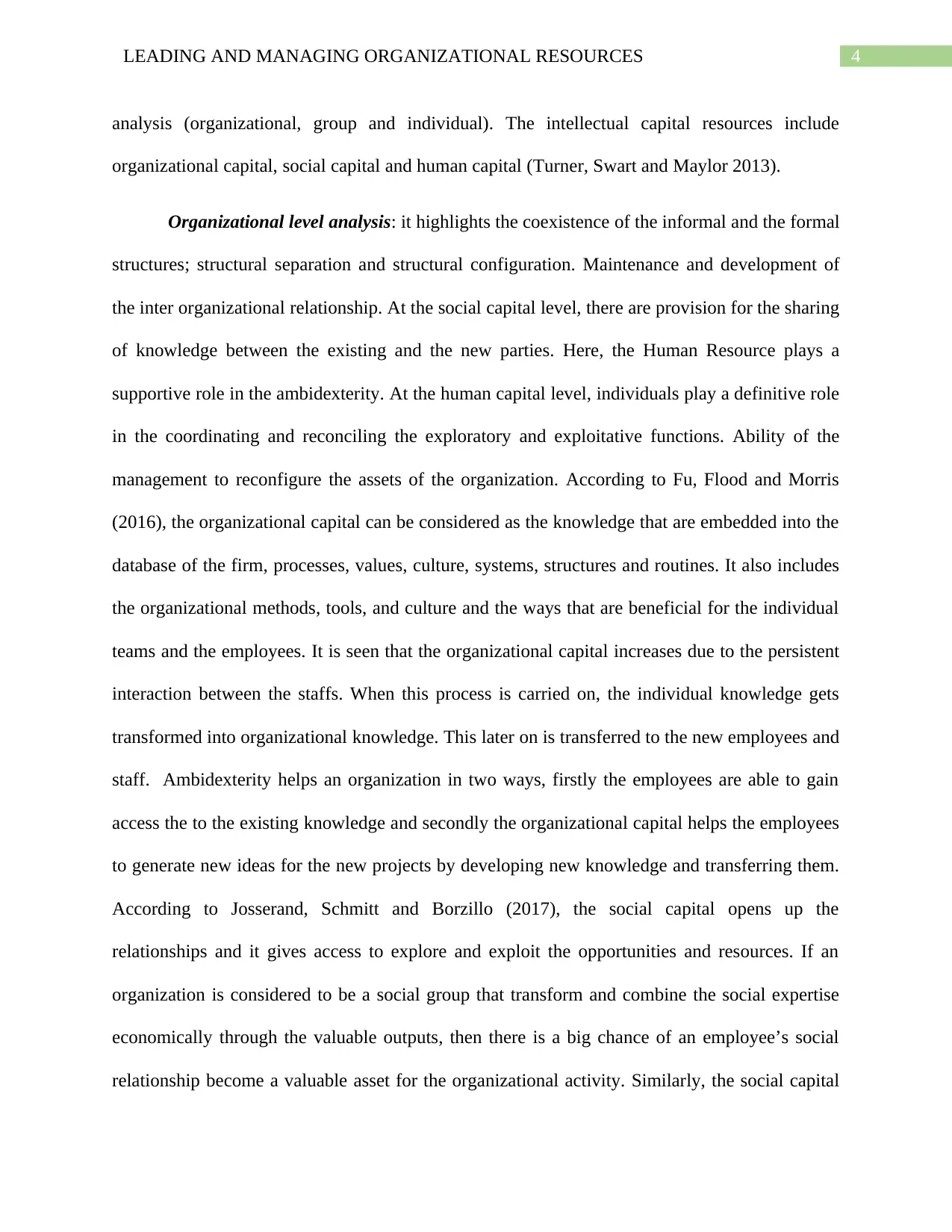
4LEADING AND MANAGING ORGANIZATIONAL RESOURCES
analysis (organizational, group and individual). The intellectual capital resources include
organizational capital, social capital and human capital (Turner, Swart and Maylor 2013).
Organizational level analysis: it highlights the coexistence of the informal and the formal
structures; structural separation and structural configuration. Maintenance and development of
the inter organizational relationship. At the social capital level, there are provision for the sharing
of knowledge between the existing and the new parties. Here, the Human Resource plays a
supportive role in the ambidexterity. At the human capital level, individuals play a definitive role
in the coordinating and reconciling the exploratory and exploitative functions. Ability of the
management to reconfigure the assets of the organization. According to Fu, Flood and Morris
(2016), the organizational capital can be considered as the knowledge that are embedded into the
database of the firm, processes, values, culture, systems, structures and routines. It also includes
the organizational methods, tools, and culture and the ways that are beneficial for the individual
teams and the employees. It is seen that the organizational capital increases due to the persistent
interaction between the staffs. When this process is carried on, the individual knowledge gets
transformed into organizational knowledge. This later on is transferred to the new employees and
staff. Ambidexterity helps an organization in two ways, firstly the employees are able to gain
access the to the existing knowledge and secondly the organizational capital helps the employees
to generate new ideas for the new projects by developing new knowledge and transferring them.
According to Josserand, Schmitt and Borzillo (2017), the social capital opens up the
relationships and it gives access to explore and exploit the opportunities and resources. If an
organization is considered to be a social group that transform and combine the social expertise
economically through the valuable outputs, then there is a big chance of an employee’s social
relationship become a valuable asset for the organizational activity. Similarly, the social capital
analysis (organizational, group and individual). The intellectual capital resources include
organizational capital, social capital and human capital (Turner, Swart and Maylor 2013).
Organizational level analysis: it highlights the coexistence of the informal and the formal
structures; structural separation and structural configuration. Maintenance and development of
the inter organizational relationship. At the social capital level, there are provision for the sharing
of knowledge between the existing and the new parties. Here, the Human Resource plays a
supportive role in the ambidexterity. At the human capital level, individuals play a definitive role
in the coordinating and reconciling the exploratory and exploitative functions. Ability of the
management to reconfigure the assets of the organization. According to Fu, Flood and Morris
(2016), the organizational capital can be considered as the knowledge that are embedded into the
database of the firm, processes, values, culture, systems, structures and routines. It also includes
the organizational methods, tools, and culture and the ways that are beneficial for the individual
teams and the employees. It is seen that the organizational capital increases due to the persistent
interaction between the staffs. When this process is carried on, the individual knowledge gets
transformed into organizational knowledge. This later on is transferred to the new employees and
staff. Ambidexterity helps an organization in two ways, firstly the employees are able to gain
access the to the existing knowledge and secondly the organizational capital helps the employees
to generate new ideas for the new projects by developing new knowledge and transferring them.
According to Josserand, Schmitt and Borzillo (2017), the social capital opens up the
relationships and it gives access to explore and exploit the opportunities and resources. If an
organization is considered to be a social group that transform and combine the social expertise
economically through the valuable outputs, then there is a big chance of an employee’s social
relationship become a valuable asset for the organizational activity. Similarly, the social capital
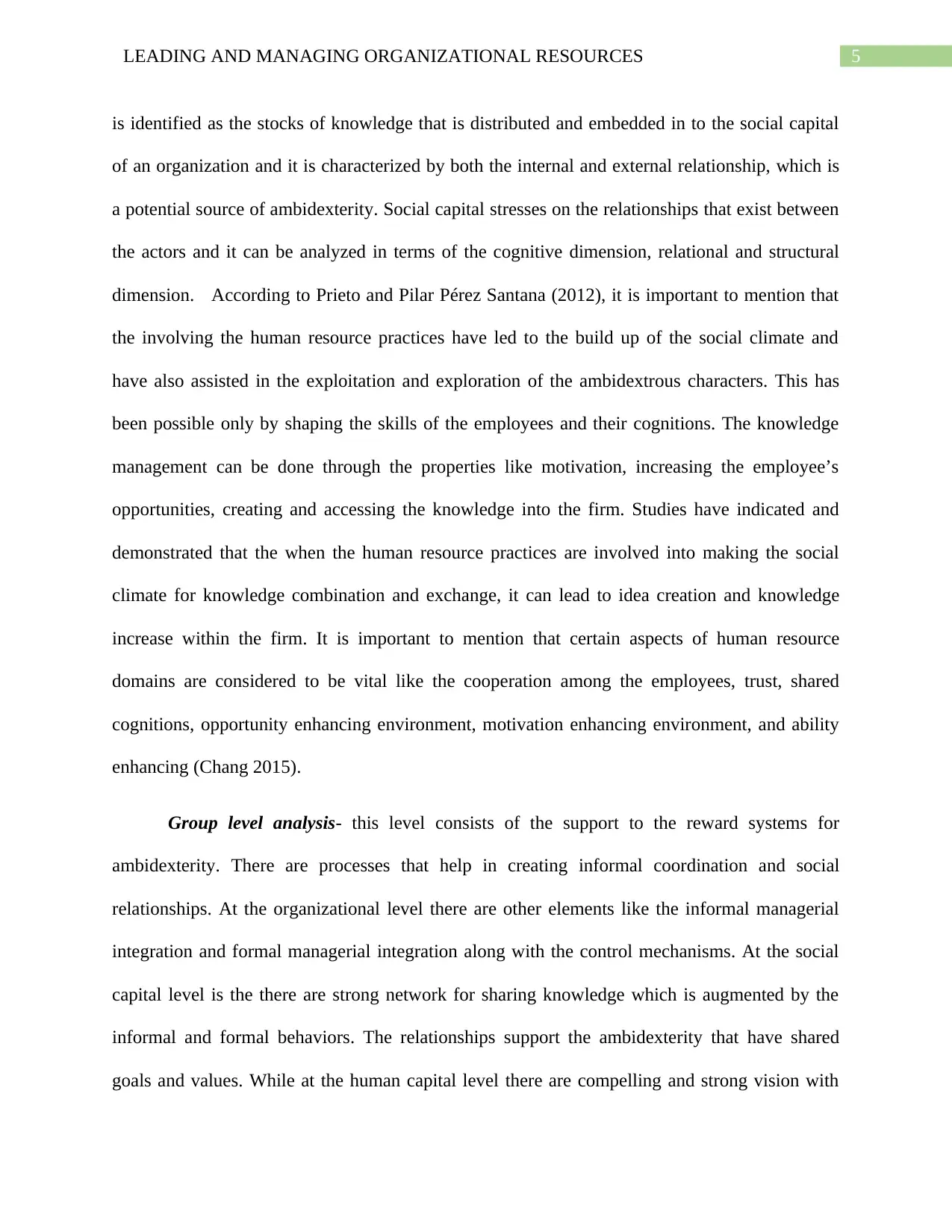
5LEADING AND MANAGING ORGANIZATIONAL RESOURCES
is identified as the stocks of knowledge that is distributed and embedded in to the social capital
of an organization and it is characterized by both the internal and external relationship, which is
a potential source of ambidexterity. Social capital stresses on the relationships that exist between
the actors and it can be analyzed in terms of the cognitive dimension, relational and structural
dimension. According to Prieto and Pilar Pérez Santana (2012), it is important to mention that
the involving the human resource practices have led to the build up of the social climate and
have also assisted in the exploitation and exploration of the ambidextrous characters. This has
been possible only by shaping the skills of the employees and their cognitions. The knowledge
management can be done through the properties like motivation, increasing the employee’s
opportunities, creating and accessing the knowledge into the firm. Studies have indicated and
demonstrated that the when the human resource practices are involved into making the social
climate for knowledge combination and exchange, it can lead to idea creation and knowledge
increase within the firm. It is important to mention that certain aspects of human resource
domains are considered to be vital like the cooperation among the employees, trust, shared
cognitions, opportunity enhancing environment, motivation enhancing environment, and ability
enhancing (Chang 2015).
Group level analysis- this level consists of the support to the reward systems for
ambidexterity. There are processes that help in creating informal coordination and social
relationships. At the organizational level there are other elements like the informal managerial
integration and formal managerial integration along with the control mechanisms. At the social
capital level is the there are strong network for sharing knowledge which is augmented by the
informal and formal behaviors. The relationships support the ambidexterity that have shared
goals and values. While at the human capital level there are compelling and strong vision with
is identified as the stocks of knowledge that is distributed and embedded in to the social capital
of an organization and it is characterized by both the internal and external relationship, which is
a potential source of ambidexterity. Social capital stresses on the relationships that exist between
the actors and it can be analyzed in terms of the cognitive dimension, relational and structural
dimension. According to Prieto and Pilar Pérez Santana (2012), it is important to mention that
the involving the human resource practices have led to the build up of the social climate and
have also assisted in the exploitation and exploration of the ambidextrous characters. This has
been possible only by shaping the skills of the employees and their cognitions. The knowledge
management can be done through the properties like motivation, increasing the employee’s
opportunities, creating and accessing the knowledge into the firm. Studies have indicated and
demonstrated that the when the human resource practices are involved into making the social
climate for knowledge combination and exchange, it can lead to idea creation and knowledge
increase within the firm. It is important to mention that certain aspects of human resource
domains are considered to be vital like the cooperation among the employees, trust, shared
cognitions, opportunity enhancing environment, motivation enhancing environment, and ability
enhancing (Chang 2015).
Group level analysis- this level consists of the support to the reward systems for
ambidexterity. There are processes that help in creating informal coordination and social
relationships. At the organizational level there are other elements like the informal managerial
integration and formal managerial integration along with the control mechanisms. At the social
capital level is the there are strong network for sharing knowledge which is augmented by the
informal and formal behaviors. The relationships support the ambidexterity that have shared
goals and values. While at the human capital level there are compelling and strong vision with
⊘ This is a preview!⊘
Do you want full access?
Subscribe today to unlock all pages.

Trusted by 1+ million students worldwide
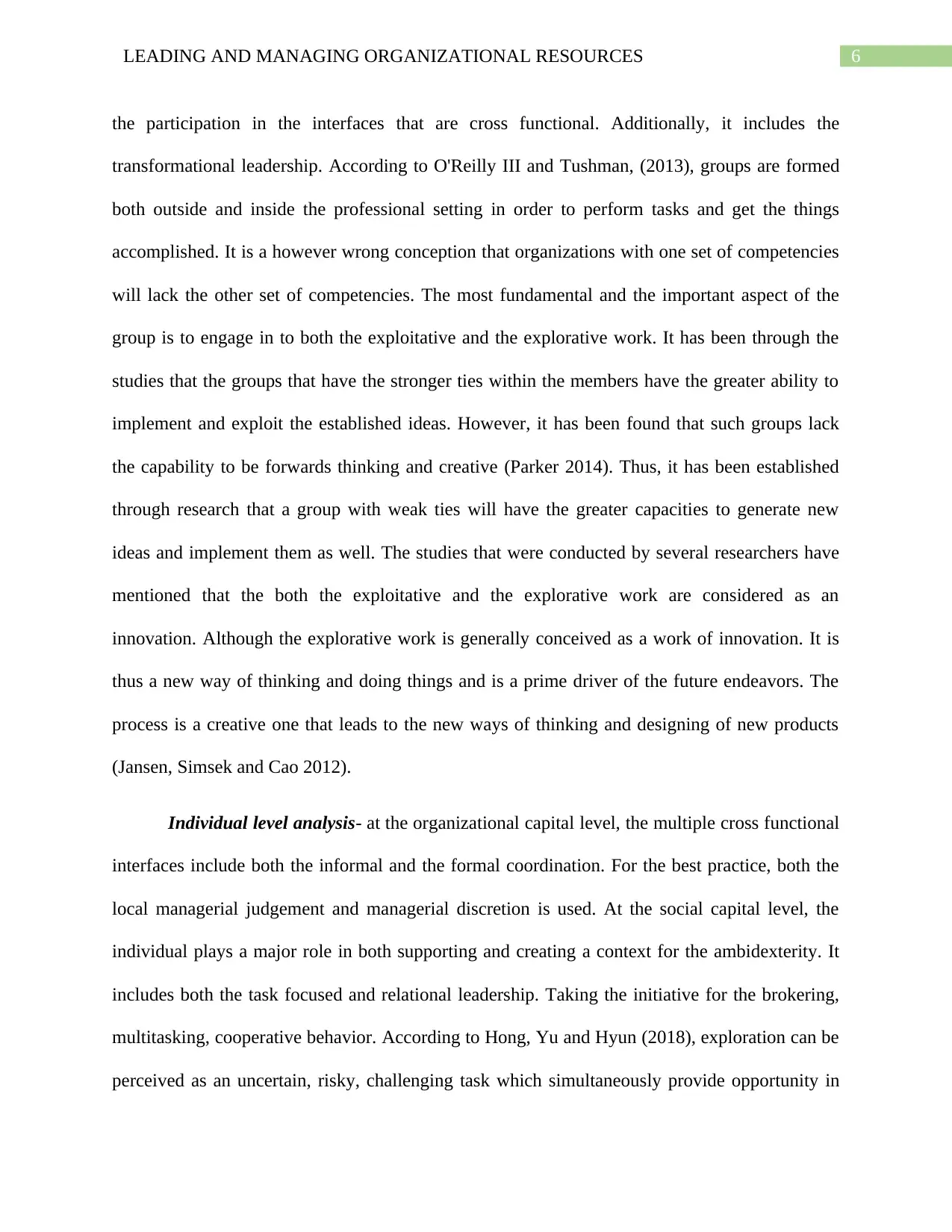
6LEADING AND MANAGING ORGANIZATIONAL RESOURCES
the participation in the interfaces that are cross functional. Additionally, it includes the
transformational leadership. According to O'Reilly III and Tushman, (2013), groups are formed
both outside and inside the professional setting in order to perform tasks and get the things
accomplished. It is a however wrong conception that organizations with one set of competencies
will lack the other set of competencies. The most fundamental and the important aspect of the
group is to engage in to both the exploitative and the explorative work. It has been through the
studies that the groups that have the stronger ties within the members have the greater ability to
implement and exploit the established ideas. However, it has been found that such groups lack
the capability to be forwards thinking and creative (Parker 2014). Thus, it has been established
through research that a group with weak ties will have the greater capacities to generate new
ideas and implement them as well. The studies that were conducted by several researchers have
mentioned that the both the exploitative and the explorative work are considered as an
innovation. Although the explorative work is generally conceived as a work of innovation. It is
thus a new way of thinking and doing things and is a prime driver of the future endeavors. The
process is a creative one that leads to the new ways of thinking and designing of new products
(Jansen, Simsek and Cao 2012).
Individual level analysis- at the organizational capital level, the multiple cross functional
interfaces include both the informal and the formal coordination. For the best practice, both the
local managerial judgement and managerial discretion is used. At the social capital level, the
individual plays a major role in both supporting and creating a context for the ambidexterity. It
includes both the task focused and relational leadership. Taking the initiative for the brokering,
multitasking, cooperative behavior. According to Hong, Yu and Hyun (2018), exploration can be
perceived as an uncertain, risky, challenging task which simultaneously provide opportunity in
the participation in the interfaces that are cross functional. Additionally, it includes the
transformational leadership. According to O'Reilly III and Tushman, (2013), groups are formed
both outside and inside the professional setting in order to perform tasks and get the things
accomplished. It is a however wrong conception that organizations with one set of competencies
will lack the other set of competencies. The most fundamental and the important aspect of the
group is to engage in to both the exploitative and the explorative work. It has been through the
studies that the groups that have the stronger ties within the members have the greater ability to
implement and exploit the established ideas. However, it has been found that such groups lack
the capability to be forwards thinking and creative (Parker 2014). Thus, it has been established
through research that a group with weak ties will have the greater capacities to generate new
ideas and implement them as well. The studies that were conducted by several researchers have
mentioned that the both the exploitative and the explorative work are considered as an
innovation. Although the explorative work is generally conceived as a work of innovation. It is
thus a new way of thinking and doing things and is a prime driver of the future endeavors. The
process is a creative one that leads to the new ways of thinking and designing of new products
(Jansen, Simsek and Cao 2012).
Individual level analysis- at the organizational capital level, the multiple cross functional
interfaces include both the informal and the formal coordination. For the best practice, both the
local managerial judgement and managerial discretion is used. At the social capital level, the
individual plays a major role in both supporting and creating a context for the ambidexterity. It
includes both the task focused and relational leadership. Taking the initiative for the brokering,
multitasking, cooperative behavior. According to Hong, Yu and Hyun (2018), exploration can be
perceived as an uncertain, risky, challenging task which simultaneously provide opportunity in
Paraphrase This Document
Need a fresh take? Get an instant paraphrase of this document with our AI Paraphraser
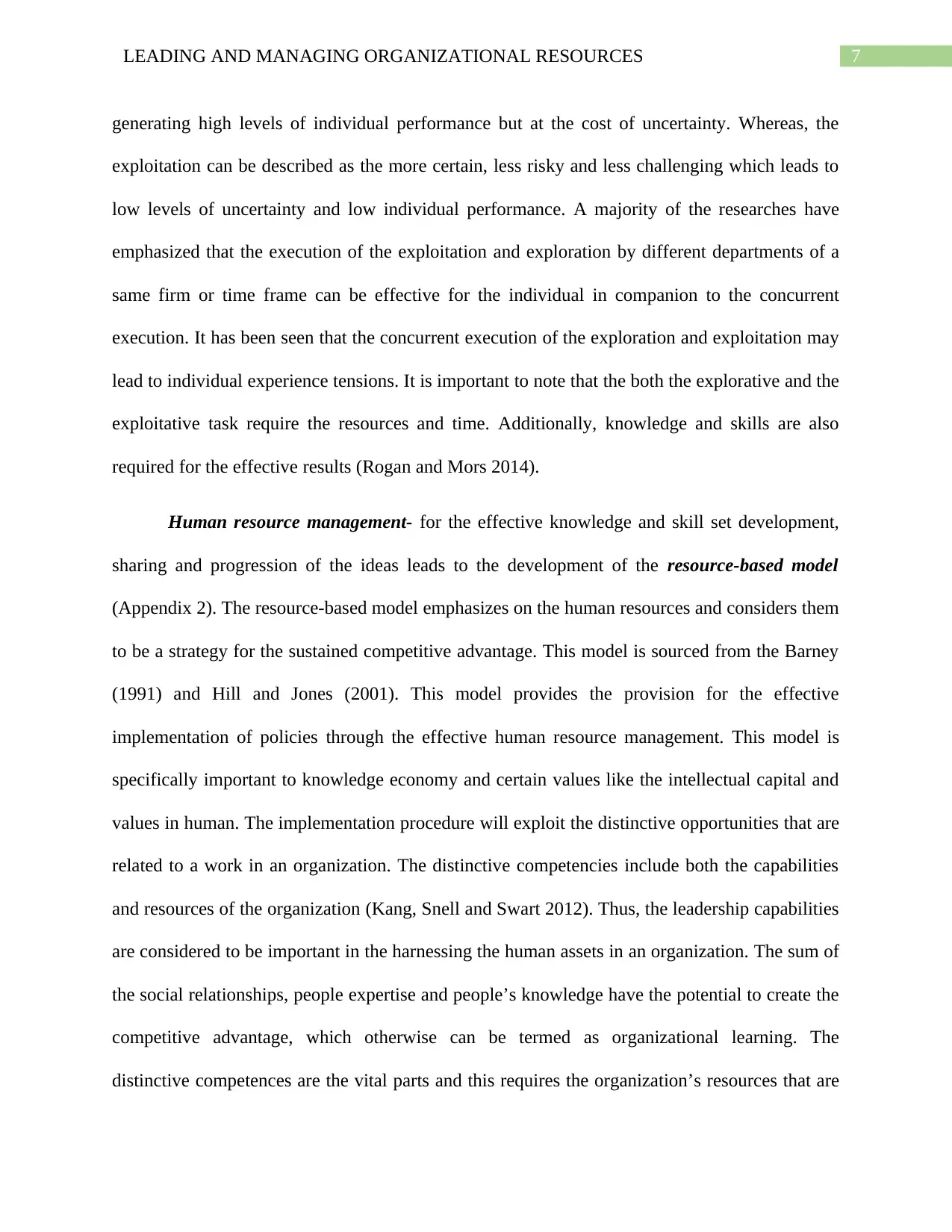
7LEADING AND MANAGING ORGANIZATIONAL RESOURCES
generating high levels of individual performance but at the cost of uncertainty. Whereas, the
exploitation can be described as the more certain, less risky and less challenging which leads to
low levels of uncertainty and low individual performance. A majority of the researches have
emphasized that the execution of the exploitation and exploration by different departments of a
same firm or time frame can be effective for the individual in companion to the concurrent
execution. It has been seen that the concurrent execution of the exploration and exploitation may
lead to individual experience tensions. It is important to note that the both the explorative and the
exploitative task require the resources and time. Additionally, knowledge and skills are also
required for the effective results (Rogan and Mors 2014).
Human resource management- for the effective knowledge and skill set development,
sharing and progression of the ideas leads to the development of the resource-based model
(Appendix 2). The resource-based model emphasizes on the human resources and considers them
to be a strategy for the sustained competitive advantage. This model is sourced from the Barney
(1991) and Hill and Jones (2001). This model provides the provision for the effective
implementation of policies through the effective human resource management. This model is
specifically important to knowledge economy and certain values like the intellectual capital and
values in human. The implementation procedure will exploit the distinctive opportunities that are
related to a work in an organization. The distinctive competencies include both the capabilities
and resources of the organization (Kang, Snell and Swart 2012). Thus, the leadership capabilities
are considered to be important in the harnessing the human assets in an organization. The sum of
the social relationships, people expertise and people’s knowledge have the potential to create the
competitive advantage, which otherwise can be termed as organizational learning. The
distinctive competences are the vital parts and this requires the organization’s resources that are
generating high levels of individual performance but at the cost of uncertainty. Whereas, the
exploitation can be described as the more certain, less risky and less challenging which leads to
low levels of uncertainty and low individual performance. A majority of the researches have
emphasized that the execution of the exploitation and exploration by different departments of a
same firm or time frame can be effective for the individual in companion to the concurrent
execution. It has been seen that the concurrent execution of the exploration and exploitation may
lead to individual experience tensions. It is important to note that the both the explorative and the
exploitative task require the resources and time. Additionally, knowledge and skills are also
required for the effective results (Rogan and Mors 2014).
Human resource management- for the effective knowledge and skill set development,
sharing and progression of the ideas leads to the development of the resource-based model
(Appendix 2). The resource-based model emphasizes on the human resources and considers them
to be a strategy for the sustained competitive advantage. This model is sourced from the Barney
(1991) and Hill and Jones (2001). This model provides the provision for the effective
implementation of policies through the effective human resource management. This model is
specifically important to knowledge economy and certain values like the intellectual capital and
values in human. The implementation procedure will exploit the distinctive opportunities that are
related to a work in an organization. The distinctive competencies include both the capabilities
and resources of the organization (Kang, Snell and Swart 2012). Thus, the leadership capabilities
are considered to be important in the harnessing the human assets in an organization. The sum of
the social relationships, people expertise and people’s knowledge have the potential to create the
competitive advantage, which otherwise can be termed as organizational learning. The
distinctive competences are the vital parts and this requires the organization’s resources that are
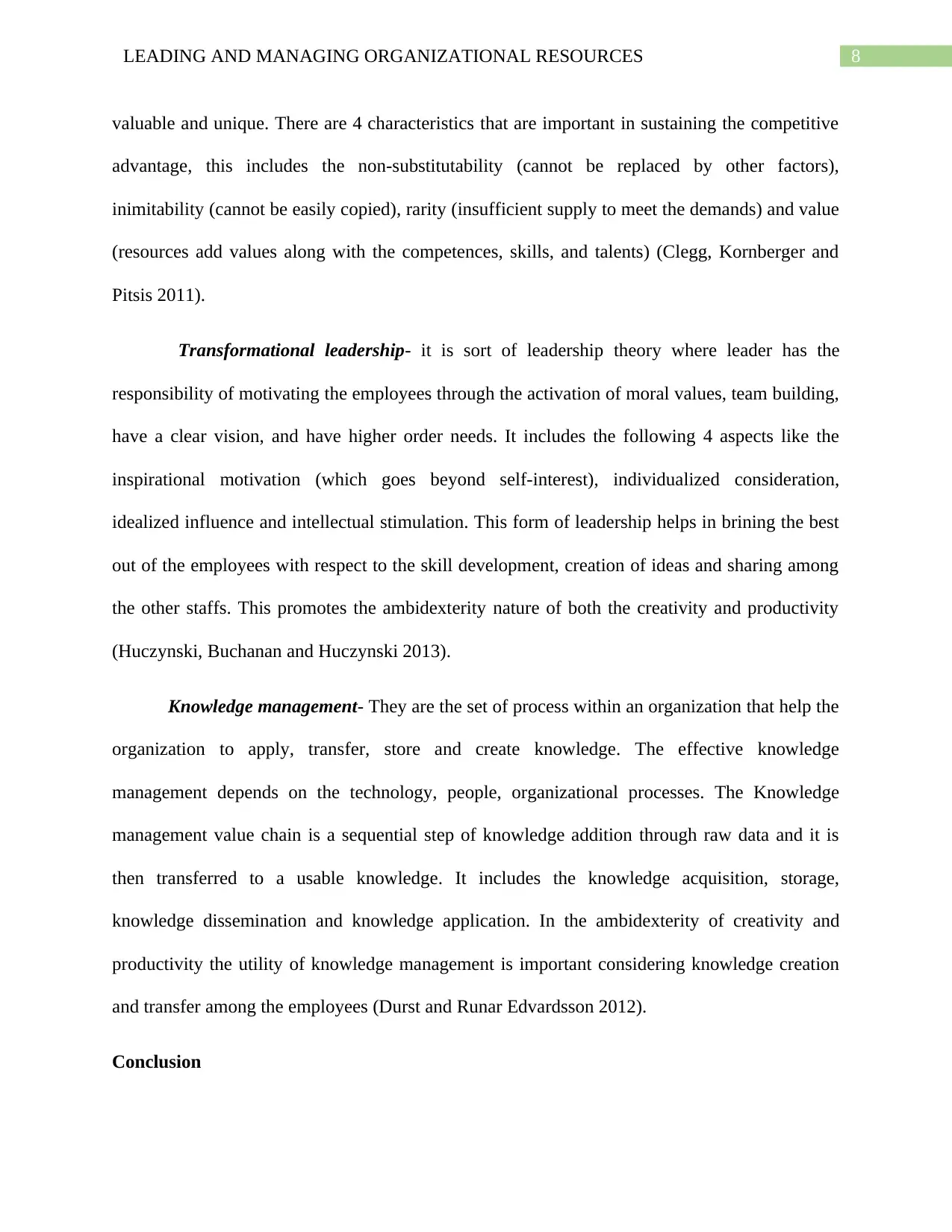
8LEADING AND MANAGING ORGANIZATIONAL RESOURCES
valuable and unique. There are 4 characteristics that are important in sustaining the competitive
advantage, this includes the non-substitutability (cannot be replaced by other factors),
inimitability (cannot be easily copied), rarity (insufficient supply to meet the demands) and value
(resources add values along with the competences, skills, and talents) (Clegg, Kornberger and
Pitsis 2011).
Transformational leadership- it is sort of leadership theory where leader has the
responsibility of motivating the employees through the activation of moral values, team building,
have a clear vision, and have higher order needs. It includes the following 4 aspects like the
inspirational motivation (which goes beyond self-interest), individualized consideration,
idealized influence and intellectual stimulation. This form of leadership helps in brining the best
out of the employees with respect to the skill development, creation of ideas and sharing among
the other staffs. This promotes the ambidexterity nature of both the creativity and productivity
(Huczynski, Buchanan and Huczynski 2013).
Knowledge management- They are the set of process within an organization that help the
organization to apply, transfer, store and create knowledge. The effective knowledge
management depends on the technology, people, organizational processes. The Knowledge
management value chain is a sequential step of knowledge addition through raw data and it is
then transferred to a usable knowledge. It includes the knowledge acquisition, storage,
knowledge dissemination and knowledge application. In the ambidexterity of creativity and
productivity the utility of knowledge management is important considering knowledge creation
and transfer among the employees (Durst and Runar Edvardsson 2012).
Conclusion
valuable and unique. There are 4 characteristics that are important in sustaining the competitive
advantage, this includes the non-substitutability (cannot be replaced by other factors),
inimitability (cannot be easily copied), rarity (insufficient supply to meet the demands) and value
(resources add values along with the competences, skills, and talents) (Clegg, Kornberger and
Pitsis 2011).
Transformational leadership- it is sort of leadership theory where leader has the
responsibility of motivating the employees through the activation of moral values, team building,
have a clear vision, and have higher order needs. It includes the following 4 aspects like the
inspirational motivation (which goes beyond self-interest), individualized consideration,
idealized influence and intellectual stimulation. This form of leadership helps in brining the best
out of the employees with respect to the skill development, creation of ideas and sharing among
the other staffs. This promotes the ambidexterity nature of both the creativity and productivity
(Huczynski, Buchanan and Huczynski 2013).
Knowledge management- They are the set of process within an organization that help the
organization to apply, transfer, store and create knowledge. The effective knowledge
management depends on the technology, people, organizational processes. The Knowledge
management value chain is a sequential step of knowledge addition through raw data and it is
then transferred to a usable knowledge. It includes the knowledge acquisition, storage,
knowledge dissemination and knowledge application. In the ambidexterity of creativity and
productivity the utility of knowledge management is important considering knowledge creation
and transfer among the employees (Durst and Runar Edvardsson 2012).
Conclusion
⊘ This is a preview!⊘
Do you want full access?
Subscribe today to unlock all pages.

Trusted by 1+ million students worldwide
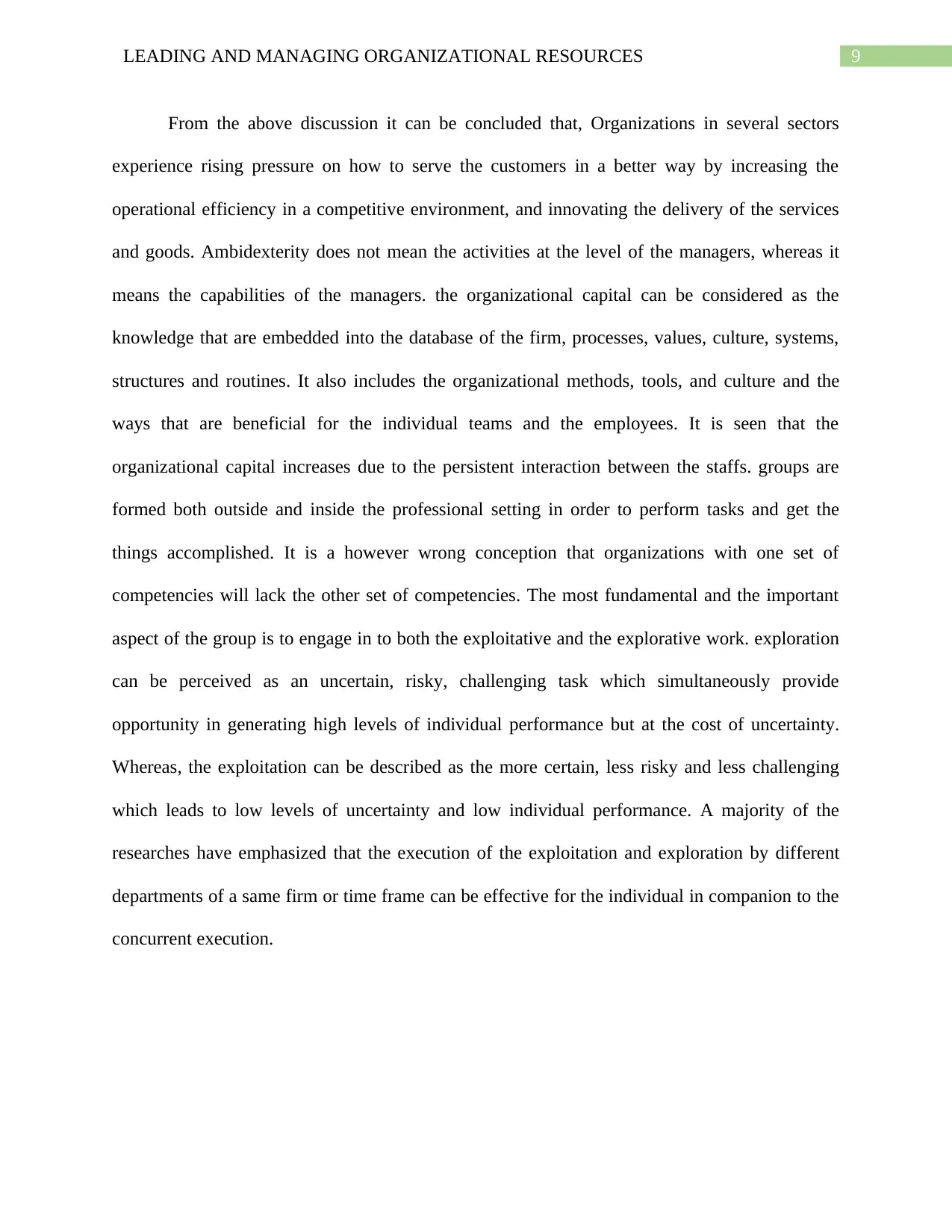
9LEADING AND MANAGING ORGANIZATIONAL RESOURCES
From the above discussion it can be concluded that, Organizations in several sectors
experience rising pressure on how to serve the customers in a better way by increasing the
operational efficiency in a competitive environment, and innovating the delivery of the services
and goods. Ambidexterity does not mean the activities at the level of the managers, whereas it
means the capabilities of the managers. the organizational capital can be considered as the
knowledge that are embedded into the database of the firm, processes, values, culture, systems,
structures and routines. It also includes the organizational methods, tools, and culture and the
ways that are beneficial for the individual teams and the employees. It is seen that the
organizational capital increases due to the persistent interaction between the staffs. groups are
formed both outside and inside the professional setting in order to perform tasks and get the
things accomplished. It is a however wrong conception that organizations with one set of
competencies will lack the other set of competencies. The most fundamental and the important
aspect of the group is to engage in to both the exploitative and the explorative work. exploration
can be perceived as an uncertain, risky, challenging task which simultaneously provide
opportunity in generating high levels of individual performance but at the cost of uncertainty.
Whereas, the exploitation can be described as the more certain, less risky and less challenging
which leads to low levels of uncertainty and low individual performance. A majority of the
researches have emphasized that the execution of the exploitation and exploration by different
departments of a same firm or time frame can be effective for the individual in companion to the
concurrent execution.
From the above discussion it can be concluded that, Organizations in several sectors
experience rising pressure on how to serve the customers in a better way by increasing the
operational efficiency in a competitive environment, and innovating the delivery of the services
and goods. Ambidexterity does not mean the activities at the level of the managers, whereas it
means the capabilities of the managers. the organizational capital can be considered as the
knowledge that are embedded into the database of the firm, processes, values, culture, systems,
structures and routines. It also includes the organizational methods, tools, and culture and the
ways that are beneficial for the individual teams and the employees. It is seen that the
organizational capital increases due to the persistent interaction between the staffs. groups are
formed both outside and inside the professional setting in order to perform tasks and get the
things accomplished. It is a however wrong conception that organizations with one set of
competencies will lack the other set of competencies. The most fundamental and the important
aspect of the group is to engage in to both the exploitative and the explorative work. exploration
can be perceived as an uncertain, risky, challenging task which simultaneously provide
opportunity in generating high levels of individual performance but at the cost of uncertainty.
Whereas, the exploitation can be described as the more certain, less risky and less challenging
which leads to low levels of uncertainty and low individual performance. A majority of the
researches have emphasized that the execution of the exploitation and exploration by different
departments of a same firm or time frame can be effective for the individual in companion to the
concurrent execution.
Paraphrase This Document
Need a fresh take? Get an instant paraphrase of this document with our AI Paraphraser
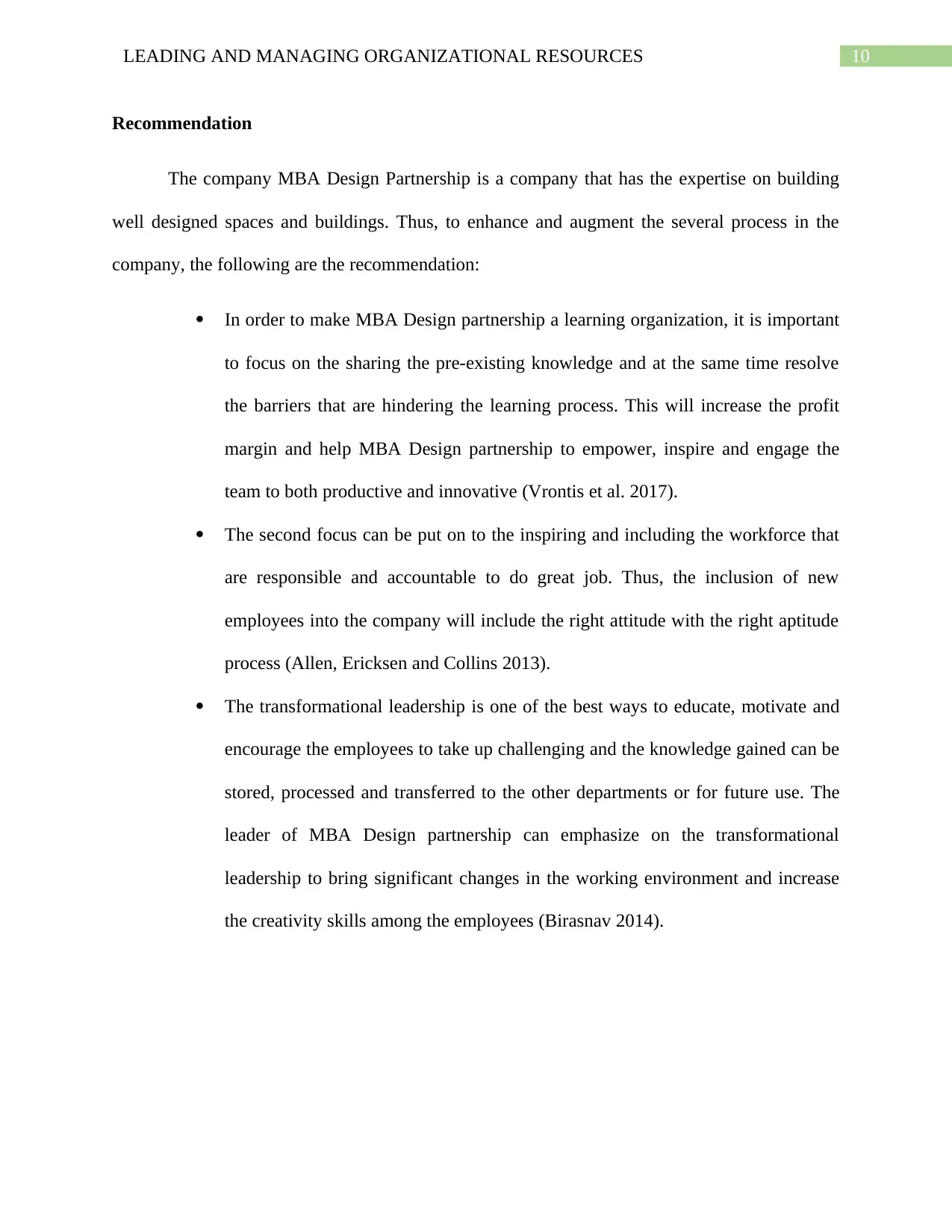
10LEADING AND MANAGING ORGANIZATIONAL RESOURCES
Recommendation
The company MBA Design Partnership is a company that has the expertise on building
well designed spaces and buildings. Thus, to enhance and augment the several process in the
company, the following are the recommendation:
In order to make MBA Design partnership a learning organization, it is important
to focus on the sharing the pre-existing knowledge and at the same time resolve
the barriers that are hindering the learning process. This will increase the profit
margin and help MBA Design partnership to empower, inspire and engage the
team to both productive and innovative (Vrontis et al. 2017).
The second focus can be put on to the inspiring and including the workforce that
are responsible and accountable to do great job. Thus, the inclusion of new
employees into the company will include the right attitude with the right aptitude
process (Allen, Ericksen and Collins 2013).
The transformational leadership is one of the best ways to educate, motivate and
encourage the employees to take up challenging and the knowledge gained can be
stored, processed and transferred to the other departments or for future use. The
leader of MBA Design partnership can emphasize on the transformational
leadership to bring significant changes in the working environment and increase
the creativity skills among the employees (Birasnav 2014).
Recommendation
The company MBA Design Partnership is a company that has the expertise on building
well designed spaces and buildings. Thus, to enhance and augment the several process in the
company, the following are the recommendation:
In order to make MBA Design partnership a learning organization, it is important
to focus on the sharing the pre-existing knowledge and at the same time resolve
the barriers that are hindering the learning process. This will increase the profit
margin and help MBA Design partnership to empower, inspire and engage the
team to both productive and innovative (Vrontis et al. 2017).
The second focus can be put on to the inspiring and including the workforce that
are responsible and accountable to do great job. Thus, the inclusion of new
employees into the company will include the right attitude with the right aptitude
process (Allen, Ericksen and Collins 2013).
The transformational leadership is one of the best ways to educate, motivate and
encourage the employees to take up challenging and the knowledge gained can be
stored, processed and transferred to the other departments or for future use. The
leader of MBA Design partnership can emphasize on the transformational
leadership to bring significant changes in the working environment and increase
the creativity skills among the employees (Birasnav 2014).
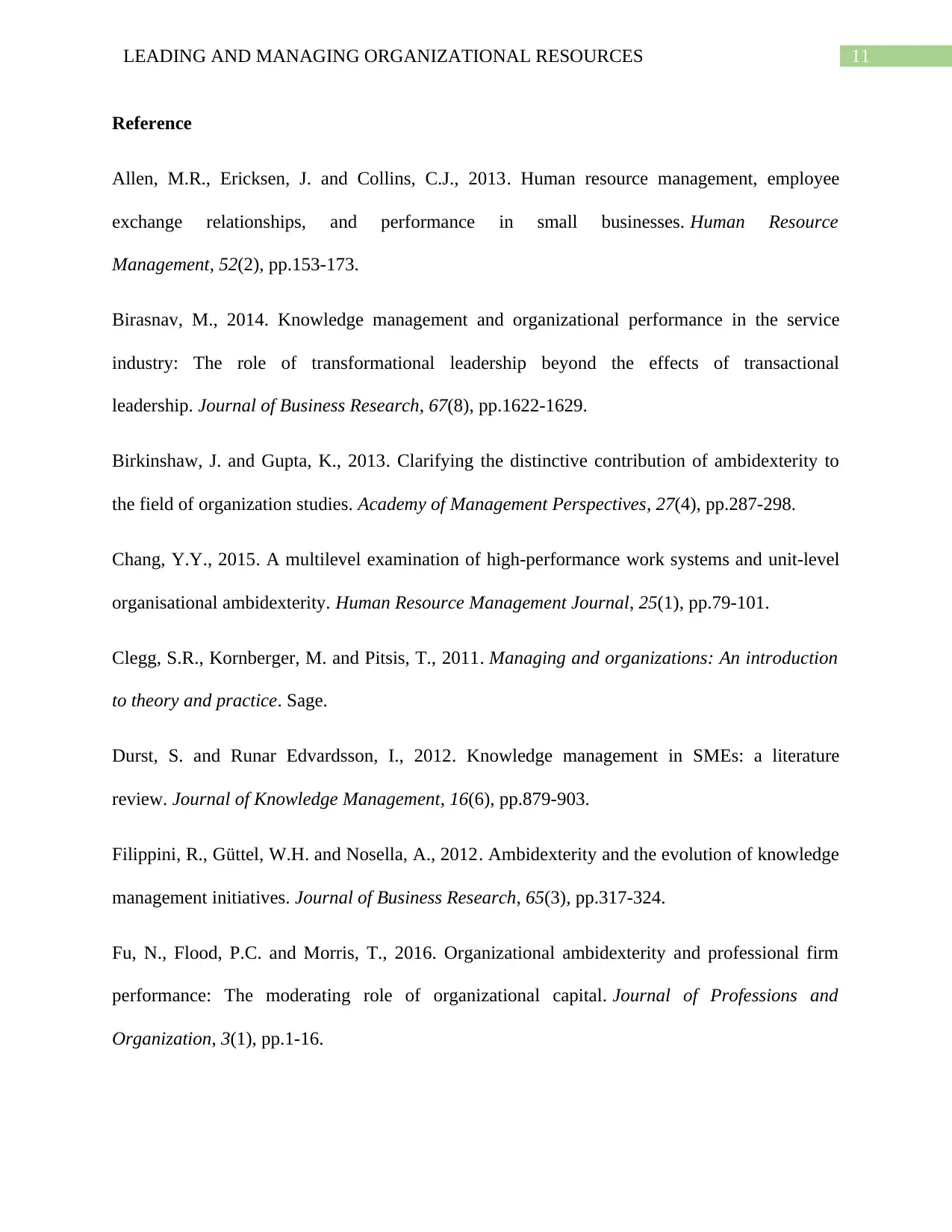
11LEADING AND MANAGING ORGANIZATIONAL RESOURCES
Reference
Allen, M.R., Ericksen, J. and Collins, C.J., 2013. Human resource management, employee
exchange relationships, and performance in small businesses. Human Resource
Management, 52(2), pp.153-173.
Birasnav, M., 2014. Knowledge management and organizational performance in the service
industry: The role of transformational leadership beyond the effects of transactional
leadership. Journal of Business Research, 67(8), pp.1622-1629.
Birkinshaw, J. and Gupta, K., 2013. Clarifying the distinctive contribution of ambidexterity to
the field of organization studies. Academy of Management Perspectives, 27(4), pp.287-298.
Chang, Y.Y., 2015. A multilevel examination of high‐performance work systems and unit‐level
organisational ambidexterity. Human Resource Management Journal, 25(1), pp.79-101.
Clegg, S.R., Kornberger, M. and Pitsis, T., 2011. Managing and organizations: An introduction
to theory and practice. Sage.
Durst, S. and Runar Edvardsson, I., 2012. Knowledge management in SMEs: a literature
review. Journal of Knowledge Management, 16(6), pp.879-903.
Filippini, R., Güttel, W.H. and Nosella, A., 2012. Ambidexterity and the evolution of knowledge
management initiatives. Journal of Business Research, 65(3), pp.317-324.
Fu, N., Flood, P.C. and Morris, T., 2016. Organizational ambidexterity and professional firm
performance: The moderating role of organizational capital. Journal of Professions and
Organization, 3(1), pp.1-16.
Reference
Allen, M.R., Ericksen, J. and Collins, C.J., 2013. Human resource management, employee
exchange relationships, and performance in small businesses. Human Resource
Management, 52(2), pp.153-173.
Birasnav, M., 2014. Knowledge management and organizational performance in the service
industry: The role of transformational leadership beyond the effects of transactional
leadership. Journal of Business Research, 67(8), pp.1622-1629.
Birkinshaw, J. and Gupta, K., 2013. Clarifying the distinctive contribution of ambidexterity to
the field of organization studies. Academy of Management Perspectives, 27(4), pp.287-298.
Chang, Y.Y., 2015. A multilevel examination of high‐performance work systems and unit‐level
organisational ambidexterity. Human Resource Management Journal, 25(1), pp.79-101.
Clegg, S.R., Kornberger, M. and Pitsis, T., 2011. Managing and organizations: An introduction
to theory and practice. Sage.
Durst, S. and Runar Edvardsson, I., 2012. Knowledge management in SMEs: a literature
review. Journal of Knowledge Management, 16(6), pp.879-903.
Filippini, R., Güttel, W.H. and Nosella, A., 2012. Ambidexterity and the evolution of knowledge
management initiatives. Journal of Business Research, 65(3), pp.317-324.
Fu, N., Flood, P.C. and Morris, T., 2016. Organizational ambidexterity and professional firm
performance: The moderating role of organizational capital. Journal of Professions and
Organization, 3(1), pp.1-16.
⊘ This is a preview!⊘
Do you want full access?
Subscribe today to unlock all pages.

Trusted by 1+ million students worldwide
1 out of 16
Related Documents
Your All-in-One AI-Powered Toolkit for Academic Success.
+13062052269
info@desklib.com
Available 24*7 on WhatsApp / Email
![[object Object]](/_next/static/media/star-bottom.7253800d.svg)
Unlock your academic potential
Copyright © 2020–2025 A2Z Services. All Rights Reserved. Developed and managed by ZUCOL.





